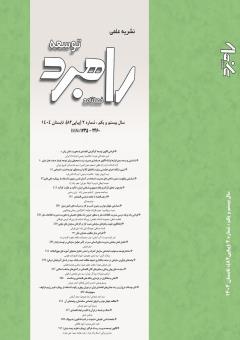تحلیل نقش میانجی مدیریت منابع انسانی سبز در تأثیر عوامل سازمانی بر توسعه پایدار
محورهای موضوعی :
1 - استادیار،گروه مدیریت دولتی، واحد سراب، دانشگاه آزاد اسلامی سراب، ایران.
کلید واژه: عوامل سازمانی, توسعه پایدار سازمانی, مدیریت منابع انسانی سبز. ,
چکیده مقاله :
هدف پژوهش، تحلیل نقش میانجی مدیریت منابع انسانی سبز در تأثیر عوامل سازمانی بر توسعه پایدار سازمانی در سازمانهای دولتی شهرستان تبریز است. روش پژوهش حاضر، توصیفی –پیمایشی و بهمنظور اندازهگیری متغیرهای پژوهش از پرسشنامه استفاده گردید. در این تحقیق جهت سنجش مولفههای تحقیق از پرسشنامه براساس طیف لیکرت استفاده میگردد و لذا برای سنجش عوامل سازمانی از پرسشنامه منوریان و کسایی ( 2007) و برای سنجش متغیر مدیریت منابع انسانی سبز از پرسشنامه آزاده صفایی و مهران نجاتی ( 2020) و برای سنجش متغیر توسعه پایدار سازمانی از پرسشنامه کر یس و همکاران ( 2006) استفاده شد. جامعه آماری پژوهش حاضر شامل مدیران و کارشناسان و کارکنان حوزه مدیریت و منابع انسانی بیش از دهها سازمان فعال در شهرستان تبریز میباشند که حجم نمونه با توجه به جدول مورگان برای تعداد جامعه نامحدود تعداد اعضای نمونه برابر 384 مورد میباشد. روش نمونه گیری بهصورت تصادفی ساده بود. برای تأیید روایی سؤالات پرسشنامه از رواییهای (صوری، تحلیل عاملی تأییدی، روایی همگرا، روایی واگرا) و جهت اطمینان از پایایی پرسشنامه، از دو معیار آلفای کرونباخ و پایایی ترکیبی استفاده گردیدهاست. نتایج این پژوهش نشانمیدهد که عوامل سازمانی بر توسعه پایدار سازمانی با تأکید بر متغیر میانجی مدیریت منابع انسانی سبز در سازمانهای دولتی شهرستان تبریز تأثیر دارد و تمامی فرضیههای پژوهش تایید گردیدند.
The aim of the Analysis of the mediating role of green human resources management in the impact of organizational factors on sustainable organizational development in public organizations of Tabriz city. The present research method is descriptive-survey and a questionnaire was used to measure the research variables. In this research, to measure the research components, a questionnaire based on the Likert scale is used, and therefore, to measure the organizational factors, the questionnaire of Manourian and Kesai (2007) and to measure the variable of green human resource management, the questionnaire of Azadeh Safai and Mehran Nejati (2020) and for The questionnaire of Chris et al. (2006) was used to measure the variable of sustainable organizational development. The statistical population of the current research includes managers, experts and employees in the field of management and human resources of more than a dozen active organizations in Tabriz city, and the sample size is 384 according to Morgan's table for the unlimited population. The sampling method was simple. To verify the validity of the questions in the questionnaire, two types of validity (face validity, confirmatory factor analysis, convergent validity, divergent validity) were used and to ensure the reliability of the questionnaire, Cronbach's alpha and composite reliability were used. The results of this research show that organizational factors have an impact on sustainable organizational development with an emphasis on the mediating variable of green human resource management in public organizations of Tabriz city, and all research hypotheses were confirmed.
منابع و مأخذ
1. ابوطالبی جهرمی، حمیدرضا و ثابت، عباس،1398، بررسی رابطه مدیریت منابع انسانی سبز و توسعه سازمانی پایدار مطالعه موردی در دانشگاه جهرم، نخستین کنفرانس ملی مدیریت، اخلاق و کسب و کار، شیراز.
2. رضایی بابک، زرگر سیدمحمد، همتیان هادی. ،1399، بررسی تأثیر ابعاد مدیریت منابع انسانی سبز بر توسعه سازمانی پایدار. آموزش علوم دریایی.
3. زرگری، کامران،1396، تأثیر عوامل داخلی سازمانی بر کارایی سیستمهای اطلاعاتی مدیریت منابع انسانی در بانکهای استان گیلان، دومین کنفرانس بین المللی مدیریت و حسابداری، تهران.
4. محمدی، حمید رضا، پور کیانی، مسعود، سلاجقه، سنجر، صیادی، سعید، ملایی، حمیدرضا. ،1399، طراحی الگو مدیریت منابع انسانی سبز با رویکرد توسعه پایدار سازمانی. دوماهنامه علمی - پژوهشی رهیافتی نو در مدیریت آموزشی.
5. AMUI, L. B. L., JABBOUR, C. J. C., DE SOUSA JABBOUR, A. B. L., and KANNAN, D. (2017). Sustainability as a dynamic organizational capability: a systematic review and a future agenda toward a sustainable transition. Journal of Cleaner Production, 142, pp. 308-322
6. ARULRAJAH, A. A., OPATHA, H.H.D.N.P., and NAWARATNE, N.N.J. (2015). Green Human Resource Management Practices: A Review. Sri Lankan Journal of Human Resource Management, 5(1), pp.1- 15.
7. BANSAL, P., and ROTH, K. (2000). Why companies go green: A model of ecological responsiveness. Academy of Management Journal, 43(4), pp. 717-736
8. MANDIP, G. (2012). Green HRM: People management commitment to environmental sustainability. Research Journal of Recent Sciences, 1(2011), pp.244- 252.
9. FAGACHIE, C. (2013). The relationship between corporate environmental performance and corporate financial performance – using the framework of corporate environmental policy implementation. M.Sc. Thesis. Faculty of Engineering, Bristol University. Bristol, UK
10. Lopes, C.M., et al. (2016),, An analysis of the interplay between organizational sustainability, knowledge management, and open innovation, Journal of Cleaner Production
11. Pavithradevi, V., and Sandhya, R.C. (2016). Green HR: Does Its Performance Match with the Value Perceived by the Employees?, International Journal Of Business & Management, March, 4(3), 312-314.
12. Qureshi, Tahir & Singh, Abhilasha & Almessabi, Balqees. (2020). Green Human Resource Management for Organizational Sustainability: A Need of the Hour for Modern Workplace. Journal of Southwest Jiaotong University. 55. 10.35741/issn.0258-2724.55.4.44.
13. Mobarez, Ayman. (2020). The effect of green human resource management on organization's Sustainable environmental performance ((Empirical Study)) / Journal of theAssociationof Arab Universities for Basic and Applied Sciences. 33.
14. Ren, S., Tang, G., & Jackson, S.E. (2018). Green human resource management research in emergence: A review and future directions. Asia Pacific Journal of Management, 35, 769-803.
15. Renwick, D.W., Redman, T., & Maguire, S. (2013). Green human resource management: a review and research agenda, International Journal of Management Reviews, 15(1), 1-14.
16. Wehrmeyer, W. (1996). Greening People, Human Resources and Environmental Management, Sheffield, Greenleaf Publishing, London, 1-356


